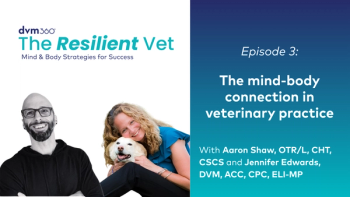
- dvm360 November 2021
- Volume 52
7 strategies to support work-life balance for your veterinary team

Top-down actions can provide a tailored work environment, improve employee retention, and strengthen morale and the bottom line.
Content submitted by Galaxy Vets, a dvm360® Strategic Alliance Partner
Work-life balance may seem elusive—always 1 choice or change away from attainment. In fact, it is the result of many mindful decisions to align 3 key priorities: work, self, and others. Achieving that balance leads to a satisfied, meaningful life that fulfills professional and personal goals.
Veterinary medicine often lacks balance. These professionals are selfless individuals committed to caring and advocating for animals, often at the expense of their own health, well-being, and personal time. Veterinarians’ exceptional devotion and emotional investment frequently lead to burnout and imbalance, sometimes driving them from the profession. According to the American Veterinary Medical Association’s (AVMA) 2020 Census of Veterinarians report, poor work-life balance is the main problem1 for veterinarians, with 75% naming it the top reason for wanting to leave the profession.
Although self-help resources are available, they are often ineffective in the veterinary work environment. Therefore, practice leaders must prioritize work-life balance. Top-down actions, such as the following 7 strategies, can provide a tailored work environment, improve employee retention, and increase morale, well-being, and the bottom line.
#1: Do not use a compensation model that incentivizes long hours
For too long, veterinarians have maintained long hours, extra shifts, and high case volume. Many production-based compensation models2 demand constant pursuit of targeted goals to meet basic cost-of-living needs and pay off mountainous student debt, to say nothing of achieving financial stability. Veterinarians may forego taking much-needed time off for fear of missing production-based pay targets. New veterinarians are more likely to experience emotional fatigue from a simple salary model that undervalues their workload. They may find themselves overwhelmed and defeated by a strictly commission-based pay scale.
Production-based compensation models that reward effort through commission and bonuses motivate workers but may also trigger unhealthy or unethical competition between veterinarians, leading to increased workplace tension. Monitor staff well-being frequently to ensure employees are not sacrificing their health or that of their patients to sustain an appropriate income.
#2: Offer flexible scheduling and part-time employment
The AVMA 2020 Economic State of the Veterinary Profession report3 proves that veterinarians want more life with their practice, but not necessarily a practice life. More veterinarians prefer working fewer hours for less compensation rather than more hours for increased income, according to the report. This preference is not limited to 1 gender—for the fourth year in a row, men and women were more likely to want fewer hours, with women only slightly ahead of men in this wish.
Part-time employees can give a practice much-needed scheduling flexibility by enabling additional appointment slots or expanded hours, such as late nights or early mornings, without forcing full-time associates into unwanted overtime. The benefits of part-time employees are reflected in the bottom line. Research4 shows that owners and associates working less than 2000 hours per year—about 40 hours per week—averaged more transactions and better gross revenue per hour than those who work more than 2000 hours per year. The data reinforce the idea that work-life balance is necessary for a sustainable, profitable practice.
#3: Increase support for parents
For veterinarians with children, work-life balance is a perpetual tug-of-war. Guilt about absence from an area of life can weigh heavily, and the impact of overlap is significant. According to research5 by dvm360®, 75% of veterinarians indicated their responsibilities as parents had interfered with their work; 87% stated their work had interfered with their duties as parents.
Parental leave and childcare expenses pose additional economic hurdles for many families on top of veterinary student debt. Practices can showcase their dedication to work-life balance by providing options like the following:
- Paid parental leave—Do not make parents choose between their work and their children. With a financial safety net in place, clinicians can step away for planned or emergency family time without guilt and return satisfied and focused.
- Financial childcare support—If each paycheck mostly covers day care costs, veterinarians may elect to leave the workforce until their children are of school age.
- In-hospital day care—Eliminate staff worries about drop-off, pickup, and coordinating schedules for their children.
#4: Hire relief veterinarians to balance the workload
The greatest asset of any practice is its workforce; recruiting relief veterinarians can be invaluable in preventing burnout and exhaustion. Relief veterinarians can help most during practice promotions, growth periods with excessive demand, staff shortages, seasonal business, or emergencies. They can provide staff with peace of mind from knowing that someone can share the load, that taking time off will not mean compromising patients or owners, and that veterinarians can temporarily step away to head off burnout.
#5: Do not promote heroism
Veterinarians often choose their profession because of their compassion, so they cannot resist a call for help or an animal in need—whether that need is urgent or could wait until tomorrow. When you love what you do, there is always a phone call to make, a topic to study, or a patient to see; however, this often comes at the expense of personal responsibilities, interests, time with family, and attention to mental health. An option we are exploring at Galaxy Vets is getting permission from veterinary teams to monitor the number of hours they spend at work through an app on their personal device to ensure they do not overwork.
Celebrating a job well done or an exceptional deed can be motivating, but praiseworthy actions can endorse self-sacrifice. Instead, consider the following strategies:
- Encourage regular breaks and protect that time.
- Ensure staff take a full lunch break.
- Provide employees with a dedicated break area or lounge to escape the clinic’s chaos.
- Block off periods on each veterinarian’s daily schedule that they can use as they choose.
- Limit the number of consecutive working hours, just as pilots or truck drivers are obligated to take breaks after a certain number of hours on duty.
Keep tabs on staff members who push through lunches or compromise their break time with interruptions and phone calls; they may need additional encouragement to turn off their “hero mode.”
#6: Talk—and listen—to your team
Knowing a team’s needs is impossible without listening. Develop a deeper understanding of your team members by learning about their lives outside the hospital. An employee’s personal interests and hobbies may reveal a compromised work-life balance. For example, a colleague who recently mentioned joining a gym but admitted missing the last few sessions may be experiencing workload-related fatigue. A few minor adjustments to hospital routine can create a supportive dialogue. Consider the following strategies:
- Set boundaries and protect personal time: Encourage employees to keep personal calendars they can check when asked to take on an extra shift, to ensure they are not sacrificing a personal event for work.
- Create a hospital vacation calendar: View vacation as a practice benefit, not a loss; rested employees have improved job satisfaction and performance. Keep track of vacation days with a dedicated calendar to ensure staff are taking enough time off.
- Hold meetings that focus on relationships, not performance: Conduct regular 1-on-1 check-ins with employees and ask for their honest answers to questions such as:
- Are you happy?
- Do you have everything you need?
- Is there anything I can help you with right now?
Consistent meetings that emphasize employee well-being set the groundwork for a trusting, productive work relationship.
#7: Sponsor healthy off-site activities
Demonstrate practice priorities by providing staff with benefits such as gym memberships, yoga classes, or massages. An Apple Watch or fitness tracker can help track sleep, exercise, and water consumption or improve eating habits. When employees see an emphasis on their mental and physical well-being, they not only reap the gift’s benefits but also feel that the practice cares about them.
What gets measured gets improved, so consider employee well-being a vital parameter of your practice and track the data with the same attention level you would give financial reports. Work-life balance metrics should be a big part of overall practice performance evaluation. Employees getting the support they need in this highly demanding profession are more resilient against stressors and more content to stay in your practice.
Although a profound professional commitment is a great asset, sacrificing personal well-being is not healthy. Veterinary professionals should avoid institutions that do not prioritize work-life balance.
Ivan “Zak” Zakharenkov, DVM, MBA, CEO of Galaxy Vets, is a veterinarian, entrepreneur, and passionate advocate for the well-being of veterinary professionals. Twelve years as an emergency department veterinarian inspired him to create Smart Flow, a first-in-the-industry workflow optimization system later acquired by Fortune 500 company IDEXX. He subsequently founded Veterinary Integration Solutions, an executive consulting firm where he helped veterinary groups systematize acquisition, integration, and improvement of practices with special attention to burnout prevention. Along the way, he obtained an MBA in international health care management with a thesis on “Implementation of Lean Thinking to Improve the Employee Experience.” Pursuing his goal to make a sizable impact on the veterinary profession, he took the lead in Galaxy Vets, a new veterinary health care system co-owned by its employees with burnout prevention as a strategic priority.
He is an active angel investor, cohost of 2 podcasts, Veterinary Innovation Podcast and Consolidate That!, and host of the Leading With Purpose webinar series.
References
- Salois M. Supporting well-being during COVID-19 and beyond. dvm360®. November 2, 2020. Accessed September 28, 2020. https://www.dvm360.com/view/supporting-well-being-during-covid-19-and-beyond
- Balabanov A. Veterinarian compensation demystified: a comprehensive guide for consolidators. Veterinary Integration Solutions. June 17, 2021. Accessed September 28, 2020.
https://vetintegrations.com/insights/veterinarian-compensation-demystified-a-comprehensive-guide-for-consolidators/ - AVMA’s latest economic report highlights growth, opportunities in veterinary profession. American Veterinary Medical Association. November 16, 2020. Accessed September 28, 2020.
https://www.avma.org/news/press-releases/avmas-latest-economic-report-highlights-growth-opportunities-veterinary - Burns K. Not enough hours in the day. American Veterinary Medical Association. February 15, 2006. Accessed September 28, 2020.
https://www.avma.org/javma-news/2006-03-01/not-enough-hours-day - Balance in parenting and vet med is hard. dvm360®. January 23, 2019. Accessed September 28, 2020.
https://www.dvm360.com/view/balance-parenting-and-vet-med-hard
Articles in this issue
almost 4 years ago
National Pet Diabetes Month: Raising awareness and making stridesabout 4 years ago
A breakthrough joint supplement for dogs and catsabout 4 years ago
Dental Pain and Inflammation—Acute and Chronicabout 4 years ago
Veterinary technicians embrace their rolesabout 4 years ago
Understanding and diagnosing canine hypothyroidismabout 4 years ago
Embark Veterinary releases first-ever purebred dog DNA kitabout 4 years ago
Zoetis adds digital cytology testing to Vetscan ImagystNewsletter
From exam room tips to practice management insights, get trusted veterinary news delivered straight to your inbox—subscribe to dvm360.






